We earn commissions if you shop through the links below. Read more
Mini Supermarket
Back to All Business Ideas

How to Start a Mini Supermarket (Small Grocery Store)
Written by: Carolyn Young
Carolyn Young is a business writer who focuses on entrepreneurial concepts and the business formation. She has over 25 years of experience in business roles, and has authored several entrepreneurship textbooks.
Edited by: David Lepeska
David has been writing and learning about business, finance and globalization for a quarter-century, starting with a small New York consulting firm in the 1990s.
Published on May 9, 2023

Investment range
$42,900 - $76,900
Revenue potential
$438,000 - $730,000 p.a.
Time to build
3 – 6 months
Profit potential
$109,500 - $182,500 p.a.
Industry trend
These are the critical aspects you should evaluate when launching your mini supermarket:
- Choose a location — Select a location with high foot traffic, visibility, and accessibility. Ensure the space is adequate for displaying products, storage, and customer movement.
- Sourcing products — Establish relationships with reputable suppliers, wholesalers, and local producers to source a diverse range of high-quality products. Curate a diverse selection of products to meet the needs and preferences of your target market.
- Retail licenses — Ensure compliance with local, state, and federal regulations regarding the sale of food and household products.
- Register your business — A limited liability company (LLC) is the best legal structure for new businesses because it is fast and simple. Form your business immediately using ZenBusiness LLC formation service or hire one of the best LLC services on the market.
- Legal business aspects — Register for taxes, open a business bank account, and get an EIN .
- Retail equipment — Purchase essential retail equipment such as refrigerators, freezers, shelving units, shopping carts, baskets, and checkout counters.
- Point of sale (POS) system — Implement a reliable POS system to handle transactions, track sales data, manage inventory, and provide customer insights. Popular options include Square, Shopify, and Clover.
- Security — Implement security measures to protect your store, inventory, staff, and customers. This includes installing surveillance cameras, alarm systems, and adequate lighting both inside and outside the store.
Interactive Checklist at your fingertips—begin your mini supermarket today!
You May Also Wonder:
Is a mini supermarket profitable?
A mini supermarket can be very profitable. It’s best to choose a niche and offer specialty items that can’t be found anywhere else.
What is the growth potential of a mini supermarket?
A successful mini supermarket could grow by expanding in size or adding new locations. It could even be a franchise opportunity.
Can you start a mini supermarket on the side?
No, a mini supermarket is definitely a full time business. It takes a lot of time to market the business and manage the store.
What is a mini supermarket called?
Mini supermarkets are sometimes called mini marts, or specialty food stores. They may also be called convenience stores.
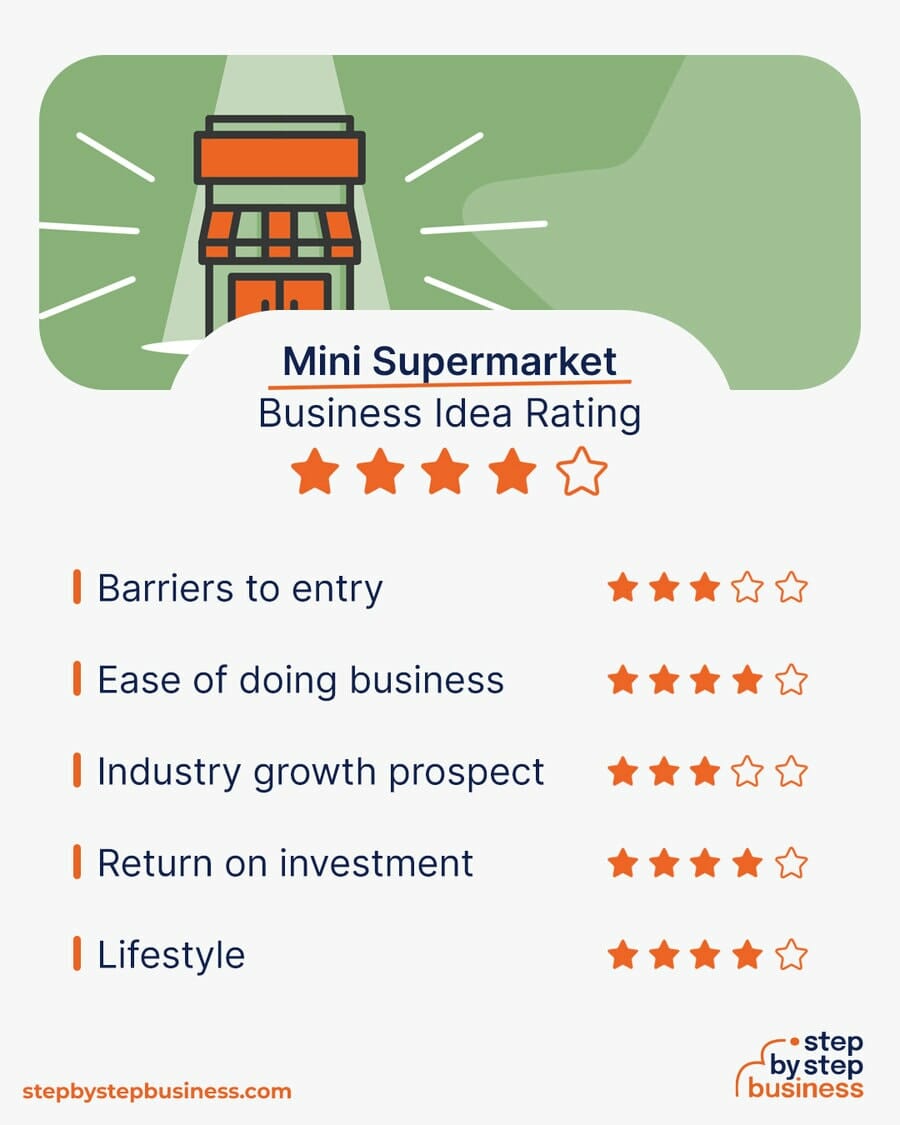
Step 1: Decide if the Business Is Right for You
Pros and cons.
- Good profit potential
- Create a competitive advantage by offering specialty foods
- Large and growing market
- High startup costs
- Takes time to build brand awareness
Mini supermarket industry trends
Industry size and growth.
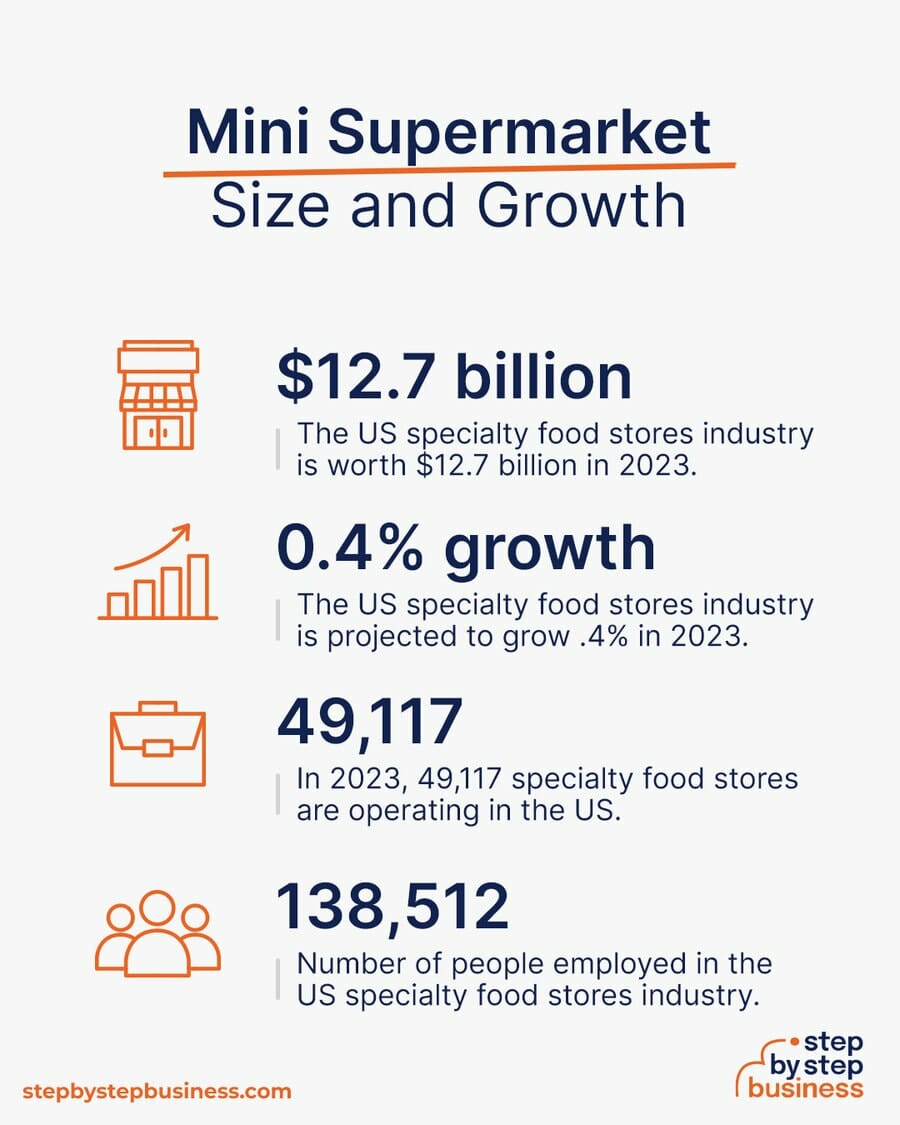
- Industry size and past growth – The U.S. specialty food stores industry is worth $12.7 billion in 2023 after growing .8% annually for the last five years.(( https://www.ibisworld.com/industry-statistics/market-size/specialty-food-stores-united-states/ ))
- Growth forecast – The U.S. specialty food stores industry is projected to grow .4% in 2023.
- Number of businesses – In 2023, 49,117 specialty food stores are operating in the U.S.(( https://www.ibisworld.com/united-states/market-research-reports/specialty-food-stores-industry/ ))
- Number of people employed – In 2023, the U.S. specialty food stores industry employs 138,512 people.
Trends and challenges
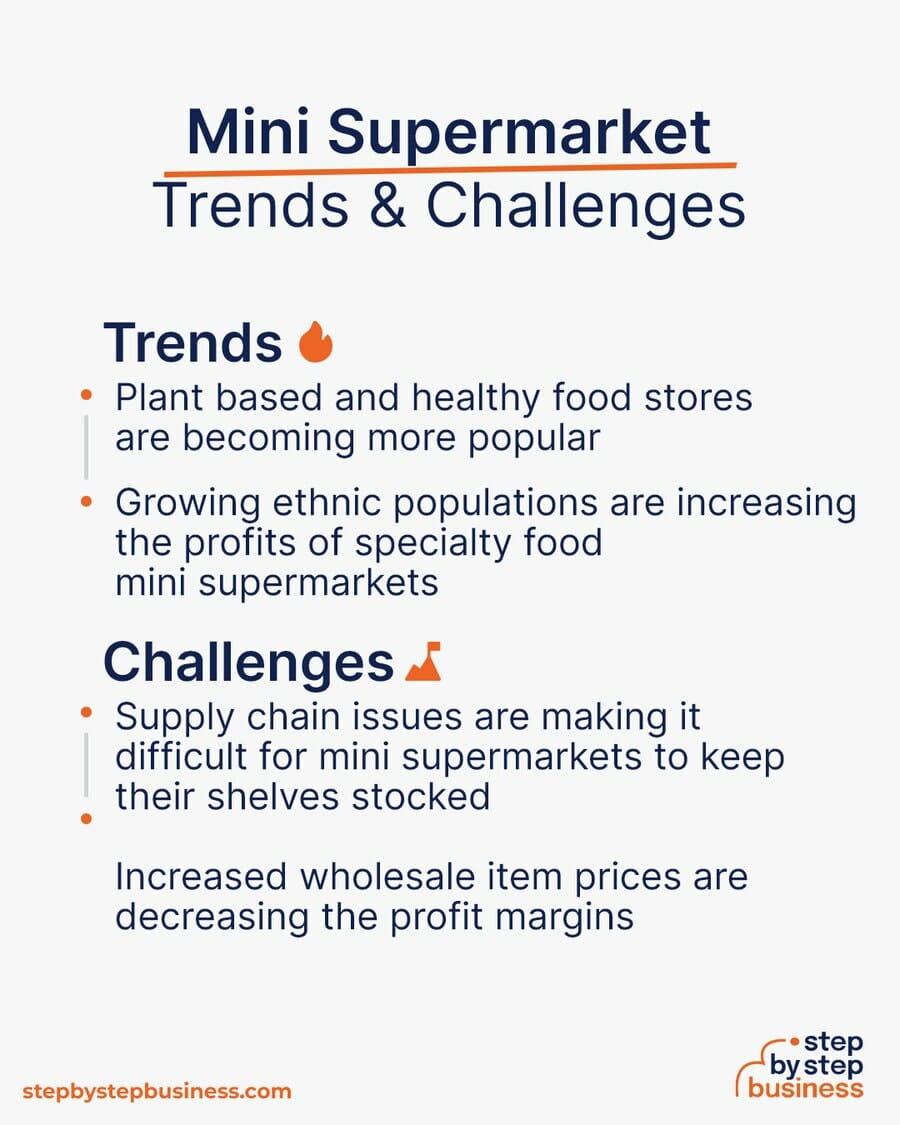
- Plant based and healthy foods specialty food stores are becoming more popular.
- Growing ethnic populations are increasing the profits of specialty food mini supermarkets.
- Supply chain issues are making it difficult for mini supermarkets to keep their shelves stocked.
- Increased wholesale item prices are decreasing the profit margins of mini supermarkets.
Demand hotspots
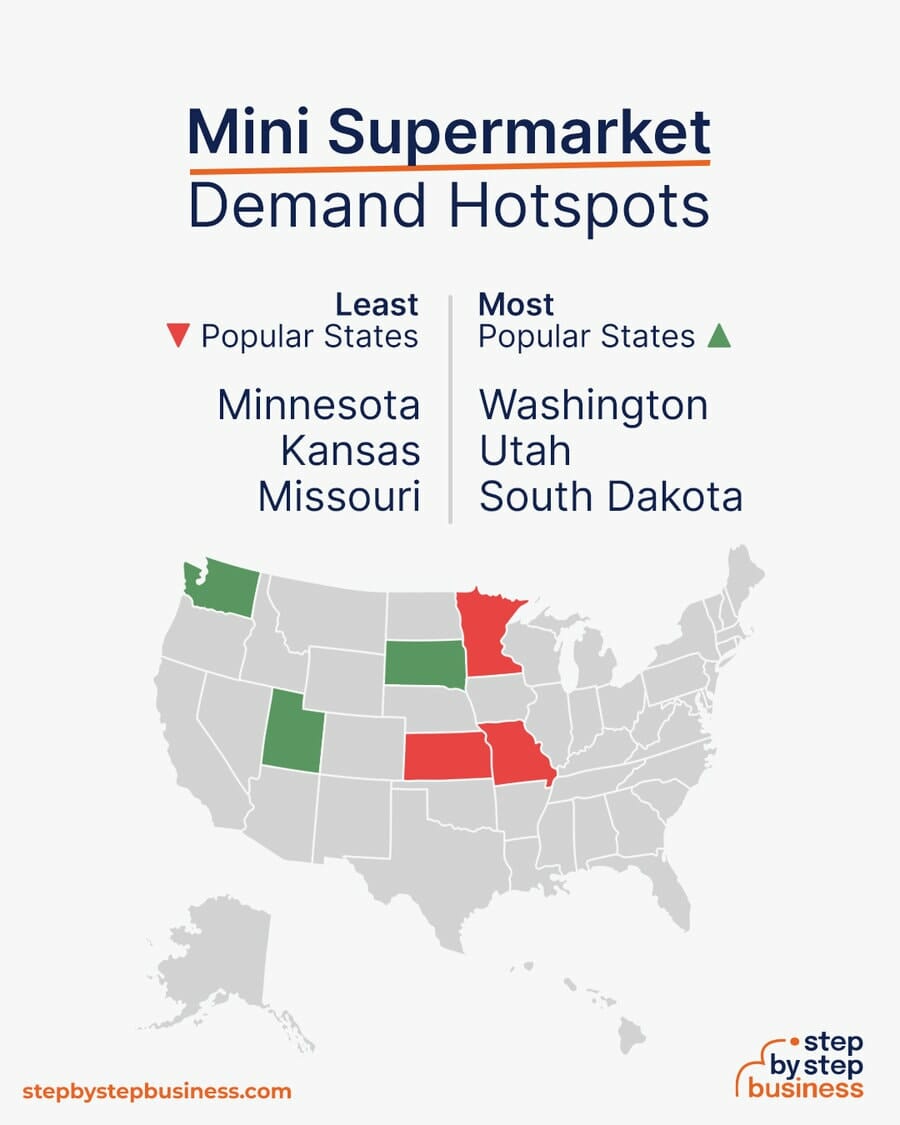
- Most popular states – The most popular states for grocery store workers are Washington, Utah, and South Dakota. (( https://www.zippia.com/grocery-worker-jobs/best-states/ ))
- Least popular states – The least popular states for grocery store workers are Maine, Iowa, and Michigan.
How much does it cost to start a mini supermarket business?
Startup costs for a mini supermarket range from $40,000 to $75,000. Costs include the space rental and preparation, inventory, and an operating budget.
You’ll need a handful of items to successfully launch your mini supermarket business, including:
- Aisle partitions
- Checkout counter
How much can you earn from a mini supermarket business?
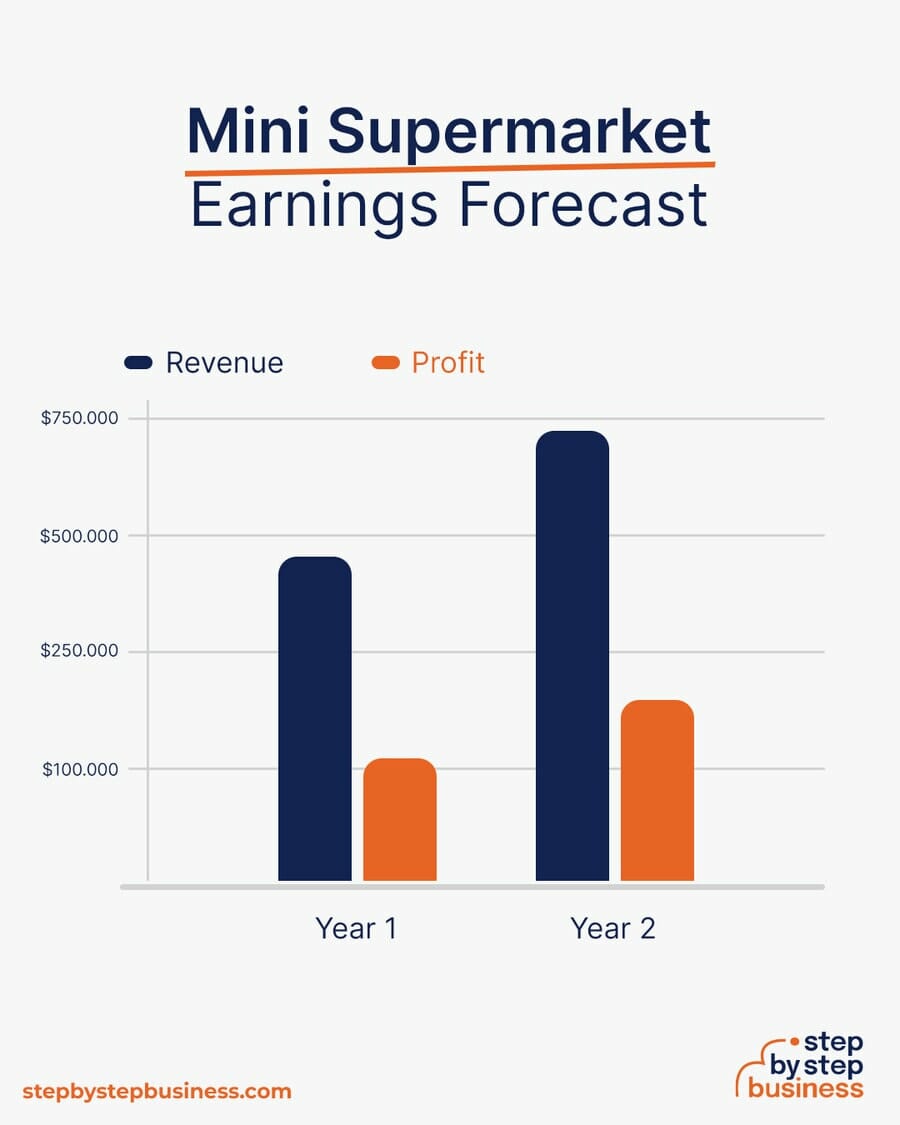
How much you charge for items will vary. These calculations will assume an average sale per customer of $40. Your profit margin should be about 25%.
In your first year or two, you might have 30 customers a day, bringing in $438,000 in revenue. This would mean $109,500 in profit, assuming that 25% margin.
As you gain traction, you might have 50 customers a day. With annual revenue of $730,000, you’d make a tidy profit of $182,500.
What barriers to entry are there?
There are a few barriers to entry for a mini supermarket. Your biggest challenges will be:
- Funding the startup costs
- Creating awareness of your store
Related Business Ideas

The Basics of Starting a Convenience Store

How to Set up and Operate a Successful Tobacco Shop

How to Start a Grocery Store: Cost and Profit Potential
Step 2: hone your idea.
Now that you know what’s involved in starting a mini supermarket, it’s a good idea to hone your concept in preparation to enter a competitive market.
Market research could give you the upper hand even if you’ve got the perfect product. Conducting robust market research is crucial, as it will help you better understand your customers, your competitors, and the broader business landscape.
Analyze your competitors
Research mini supermarkets in your area to examine their products, price points, and customer reviews.
- Make a list of businesses that offer similar products.
- Review your competitors’ products – their features, pricing, and quality – and marketing strategies.
- Check out their online reviews and ratings on Google, Yelp, and Facebook to get an idea of what their customers like and dislike.
- Identify your competitors’ strengths and weaknesses.
This should identify areas where you can strengthen your business and gain a competitive edge to make better business decisions.
Why? Identify an opportunity
You’re looking for a market gap to fill. For instance, maybe the local market is missing a small supermarket that specializes in Indian food, or a vegan grocery item mini market.
You might consider targeting a niche, such as Mexican food.
This could jumpstart your word-of-mouth marketing and attract clients right away.
What? Determine your products
You’ll need to choose the types of items that you want to offer, and select the products that are most desirable to customers. In addition to grocery items, you could also offer alcoholic beverages to increase your revenue potential.
How much should you charge for mini supermarket items?
Your pricing will depend on market prices in your area, but also on your cost to purchase the items.
Once you know your costs, use this Step By Step profit margin calculator to determine your mark-up and final price points. Remember, the prices you use at launch should be subject to change if warranted by the market.
Who? Identify your target market
Your target market will depend on your specialty. If you decide to offer vegan grocery items, your market is likely to be younger, so you can find them on TikTok or Instagram.
Where? Choose a mini supermarket location
You’ll need to rent out a store front You can find commercial space to rent in your area on sites such as Craigslist , Crexi , and Instant Offices .
When choosing a commercial space, here are some rules to follow:
- High Foot Traffic: Choose locations with a lot of pedestrian activity, as more foot traffic usually translates to more customers.
- Accessibility: Ensure the location is easily accessible by car and public transportation, allowing convenient visits for customers.
- Visibility: A spot that’s easily seen from main roads or intersections can attract spontaneous shoppers.
- Parking Availability: A location with ample parking ensures convenience for customers who drive.
- Proximity to Complementary Businesses: Being near businesses like pharmacies or banks can attract their customers after they finish their primary task.
- Safety: A safe neighborhood or area encourages more evening and nighttime shopping.
- Competitive Analysis: Avoid areas oversaturated with similar businesses to reduce direct competition.
- Demographic Match: Ensure the local demographics match your target market, catering to their shopping needs and preferences.
- Affordable Rent: Balance between a prime location and rent costs to maintain profitability.
- Future Development Plans: Research any planned developments or changes in the area which might impact future business.
Step 3: Brainstorm a Mini Supermarket Name
Here are some ideas for brainstorming your business name:
- Short, unique, and catchy names tend to stand out
- Names that are easy to say and spell tend to do better
- Name should be relevant to your product or service offerings
- Ask around — family, friends, colleagues, social media — for suggestions
- Including keywords, such as “mini mart” or “supermarket”, boosts SEO
- Name should allow for expansion, for ex: “Neighbour Nest” and “Market Mingle”over “TinyTrolley Supermarket” or “PocketPantry Mart”
- A location-based name can help establish a strong connection with your local community and help with the SEO but might hinder future expansion
Once you’ve got a list of potential names, visit the website of the US Patent and Trademark Office to make sure they are available for registration and check the availability of related domain names using our Domain Name Search tool. Using “.com” or “.org” sharply increases credibility, so it’s best to focus on these.
Find a Domain
Powered by GoDaddy.com
Finally, make your choice among the names that pass this screening and go ahead and reserve your business name with your state, start the trademark registration process, and complete your domain registration and social media account creation.
Your business name is one of the key differentiators that sets your business apart. Once you pick a name, reserve it and start with the branding, it’s hard to switch to a new name. So be sure to carefully consider your choice before moving forward.
Step 4: Create a Mini Supermarket Business Plan
Here are the key components of a business plan:

- Executive Summary: Provide a brief summary of your mini supermarket business plan, highlighting your goals and the unique selling points of your store.
- Business Overview: Describe your mini supermarket, including its size, location, and the range of grocery products and services it will offer.
- Product and Services: Detail the types of products you’ll stock, such as fresh produce, canned goods, and household essentials, as well as any additional services like a deli counter or bakery.
- Market Analysis: Analyze the local market for grocery stores, considering factors like customer demographics, shopping habits, and demand for specialty products.
- Competitive Analysis: Identify other supermarkets or grocery stores in your area, emphasizing how your store will differentiate itself, whether through pricing, product selection, or customer service.
- Sales and Marketing: Explain your strategies for attracting shoppers, including advertising, promotions, and customer loyalty programs.
- Management Team: Introduce key team members, such as store managers and cashiers, highlighting their experience in the retail industry.
- Operations Plan: Outline the day-to-day operations of your mini supermarket, covering inventory management, staff scheduling, and customer service standards.
- Financial Plan: Present financial projections, including startup costs, expected revenue, and profitability estimates based on pricing, customer traffic, and repeat business.
- Appendix: Include any licenses or permits required to operate a supermarket, as well as floor plans, supplier agreements, and a list of initial inventory.
If you’ve never created a business plan, it can be an intimidating task. You might consider hiring a business plan specialist to create a top-notch business plan for you.
Step 5: Register Your Business
Registering your business is an absolutely crucial step — it’s the prerequisite to paying taxes, raising capital, opening a bank account, and other guideposts on the road to getting a business up and running.
Plus, registration is exciting because it makes the entire process official. Once it’s complete, you’ll have your own business!
Choose where to register your company
Your business location is important because it can affect taxes, legal requirements, and revenue. Most people will register their business in the state where they live, but if you are planning to expand, you might consider looking elsewhere, as some states could offer real advantages when it comes to mini supermarkets.
If you’re willing to move, you could really maximize your business! Keep in mind, it’s relatively easy to transfer your business to another state.
Choose your business structure
Business entities come in several varieties, each with its pros and cons. The legal structure you choose for your mini supermarket will shape your taxes, personal liability, and business registration requirements, so choose wisely.
Here are the main options:

- Sole Proprietorship – The most common structure for small businesses makes no legal distinction between company and owner. All income goes to the owner, who’s also liable for any debts, losses, or liabilities incurred by the business. The owner pays taxes on business income on his or her personal tax return.
- General Partnership – Similar to a sole proprietorship, but for two or more people. Again, owners keep the profits and are liable for losses. The partners pay taxes on their share of business income on their personal tax returns.
- Limited Liability Company ( LLC ) – Combines the characteristics of corporations with those of sole proprietorships or partnerships. Again, the owners are not personally liable for debts. Here’s how to form an LLC .
- C Corp – Under this structure, the business is a distinct legal entity and the owner or owners are not personally liable for its debts. Owners take profits through shareholder dividends, rather than directly. The corporation pays taxes, and owners pay taxes on their dividends, which is sometimes referred to as double taxation. Read how to start a corporation here .
- S Corp – An S-Corporation refers to the tax classification of the business but is not a business entity. An S-Corp can be either a corporation or an LLC , which just need to elect to be an S-Corp for tax status. In an S-Corp, income is passed through directly to shareholders, who pay taxes on their share of business income on their personal tax returns.
We recommend that new business owners choose LLC as it offers liability protection and pass-through taxation while being simpler to form than a corporation. You can form an LLC in as little as five minutes using an online LLC formation service. They will check that your business name is available before filing, submit your articles of organization , and answer any questions you might have.
Form Your LLC
Choose Your State
We recommend ZenBusiness as the Best LLC Service for 2024

Step 6: Register for Taxes
The final step before you’re able to pay taxes is getting an Employer Identification Number , or EIN. You can file for your EIN online or by mail or fax: visit the IRS website to learn more. Keep in mind, if you’ve chosen to be a sole proprietorship you can simply use your social security number as your EIN.
Once you have your EIN, you’ll need to choose your tax year. Financially speaking, your business will operate in a calendar year (January–December) or a fiscal year, a 12-month period that can start in any month. This will determine your tax cycle, while your business structure will determine which taxes you’ll pay.
The IRS website also offers a tax-payers checklist , and taxes can be filed online.
It is important to consult an accountant or other professional to help you with your taxes to ensure you are completing them correctly.
Step 7: Fund your Business
Securing financing is your next step and there are plenty of ways to raise capital:
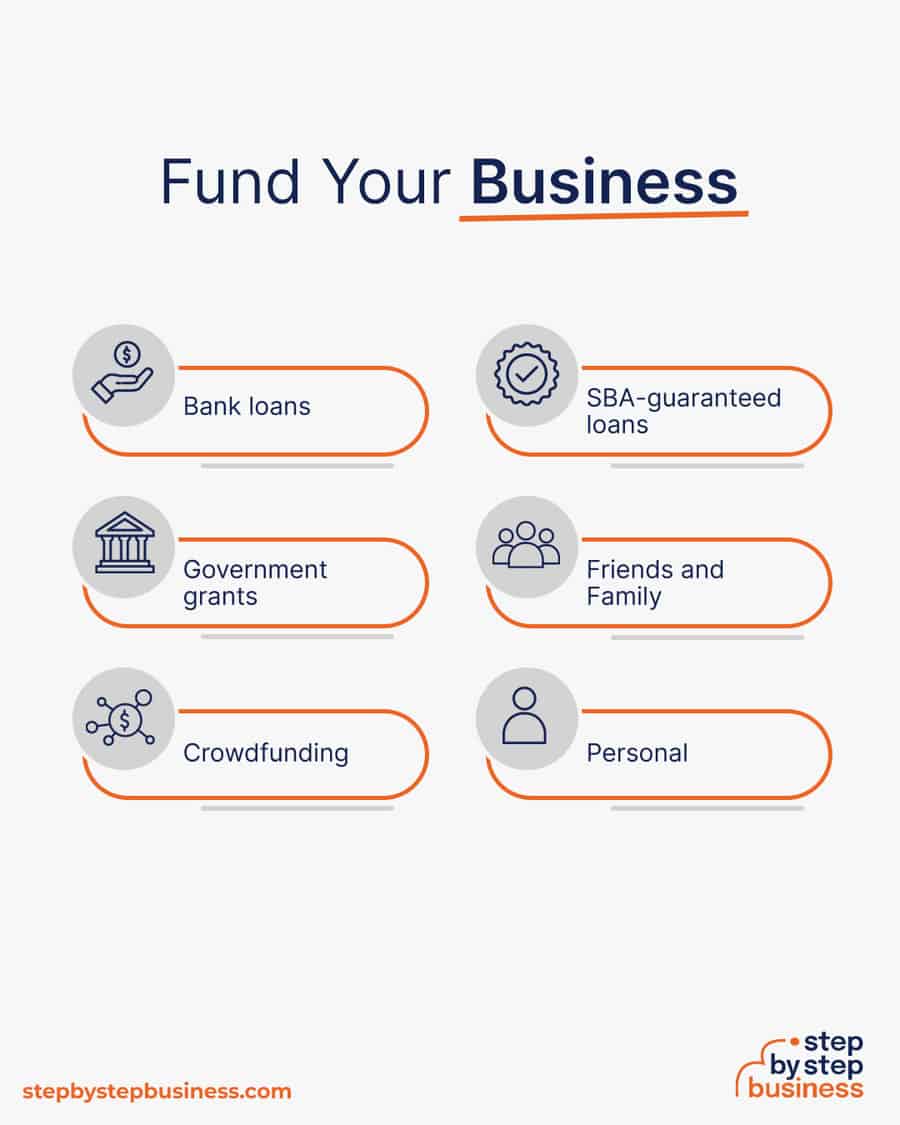
- Bank loans: This is the most common method but getting approved requires a rock-solid business plan and strong credit history.
- SBA-guaranteed loans: The Small Business Administration can act as guarantor, helping gain that elusive bank approval via an SBA-guaranteed loan .
- Government grants: A handful of financial assistance programs help fund entrepreneurs. Visit Grants.gov to learn which might work for you.
- Friends and Family: Reach out to friends and family to provide a business loan or investment in your concept. It’s a good idea to have legal advice when doing so because SEC regulations apply.
- Crowdfunding: Websites like Kickstarter and Indiegogo offer an increasingly popular low-risk option, in which donors fund your vision. Entrepreneurial crowdfunding sites like Fundable and WeFunder enable multiple investors to fund your business.
- Personal: Self-fund your business via your savings or the sale of property or other assets.
Bank and SBA loans are probably the best option, other than friends and family, for funding a mini supermarket business. You might also try crowdfunding if you have an innovative concept.
Step 8: Apply for Business Licenses and Permits
Starting a mini supermarket business requires obtaining a number of licenses and permits from local, state, and federal governments.
Federal regulations, licenses, and permits associated with starting your business include doing business as (DBA), health licenses and permits from the Occupational Safety and Health Administration ( OSHA ), trademarks, copyrights, patents, and other intellectual properties, as well as industry-specific licenses and permits.
If you offer alcoholic beverages, you’ll need to check state and local liquor licensing requirements.
You may also need state-level and local county or city-based licenses and permits. The license requirements and how to obtain them vary, so check the websites of your state, city, and county governments or contact the appropriate person to learn more.
You could also check this SBA guide for your state’s requirements, but we recommend using MyCorporation’s Business License Compliance Package . They will research the exact forms you need for your business and state and provide them to ensure you’re fully compliant.
This is not a step to be taken lightly, as failing to comply with legal requirements can result in hefty penalties.
If you feel overwhelmed by this step or don’t know how to begin, it might be a good idea to hire a professional to help you check all the legal boxes.
Step 9: Open a Business Bank Account
Before you start making money, you’ll need a place to keep it, and that requires opening a bank account .
Keeping your business finances separate from your personal account makes it easy to file taxes and track your company’s income, so it’s worth doing even if you’re running your mini supermarket business as a sole proprietorship. Opening a business bank account is quite simple, and similar to opening a personal one. Most major banks offer accounts tailored for businesses — just inquire at your preferred bank to learn about their rates and features.
Banks vary in terms of offerings, so it’s a good idea to examine your options and select the best plan for you. Once you choose your bank, bring in your EIN (or Social Security Number if you decide on a sole proprietorship), articles of incorporation, and other legal documents and open your new account.
Step 10: Get Business Insurance
Business insurance is an area that often gets overlooked yet it can be vital to your success as an entrepreneur. Insurance protects you from unexpected events that can have a devastating impact on your business.
Here are some types of insurance to consider:

- General liability: The most comprehensive type of insurance, acting as a catch-all for many business elements that require coverage. If you get just one kind of insurance, this is it. It even protects against bodily injury and property damage.
- Business Property: Provides coverage for your equipment and supplies.
- Equipment Breakdown Insurance: Covers the cost of replacing or repairing equipment that has broken due to mechanical issues.
- Worker’s compensation: Provides compensation to employees injured on the job.
- Property: Covers your physical space, whether it is a cart, storefront, or office.
- Commercial auto: Protection for your company-owned vehicle.
- Professional liability: Protects against claims from a client who says they suffered a loss due to an error or omission in your work.
- Business owner’s policy (BOP): This is an insurance plan that acts as an all-in-one insurance policy, a combination of the above insurance types.
Step 11: Prepare to Launch
As opening day nears, prepare for launch by reviewing and improving some key elements of your business.
Essential software and tools
Being an entrepreneur often means wearing many hats, from marketing to sales to accounting, which can be overwhelming. Fortunately, many websites and digital tools are available to help simplify many business tasks.
You may want to use industry-specific software, such as ITRetail , LS Retail , or ECRS , to manage your ordering, inventory, and bookkeeping.
- Popular web-based accounting programs for smaller businesses include Quickbooks , Freshbooks , and Xero .
- If you’re unfamiliar with basic accounting, you may want to hire a professional, especially as you begin. The consequences for filing incorrect tax documents can be harsh, so accuracy is crucial.
Create a website
Website development is crucial because your site is your online presence and needs to convince prospective clients of your expertise and professionalism. You can create your own website using services like WordPress, Wix, or Squarespace . This route is very affordable, but figuring out how to build a website can be time-consuming. If you lack tech-savvy, you can hire a web designer or developer to create a custom website for your business.
Your customers are unlikely to find your website, however, unless you follow Search Engine Optimization (SEO) practices. SEO will help your website appear closer to the top in relevant search results, a crucial element for increasing sales.
Make sure that you optimize calls to action on your website. Experiment with text, color, size, and position of calls to action such as “Buy Now” or “Order”. This can sharply increase purchases if you’re offering curbside pickup or delivery.
Here are some powerful marketing strategies for your future business:
- Loyalty Programs: Implement a loyalty program to reward frequent shoppers with discounts or exclusive deals, encouraging repeat business.
- In-store Promotions: Regularly host in-store promotions, such as buy-one-get-one-free offers or discounted bundles, to attract foot traffic and boost sales.
- Community Engagement: Actively participate in local events, sponsor community activities, and collaborate with nearby businesses to build strong relationships within your community.
- Social Media Contests: Run engaging contests on social media platforms, encouraging customers to share their experiences, photos, or product recommendations for a chance to win prizes.
- Personalized Marketing: Leverage customer data to send targeted promotions, personalized recommendations, and exclusive offers, enhancing the shopping experience and building customer loyalty.
- Cross-Promotions: Partner with complementary local businesses for cross-promotions, creating mutually beneficial deals that expand your customer base.
- Product Sampling: Offer free product samples or tastings in-store to introduce new items and create a positive buzz, enticing customers to make additional purchases.
- Customer Feedback Surveys: Regularly seek customer feedback through surveys to understand preferences, identify areas for improvement, and show customers that their opinions matter.
- Local SEO Optimization: Optimize your online presence for local searches by ensuring accurate business information on platforms like Google My Business, making it easier for nearby customers to find you.
- Mobile Marketing: Utilize SMS marketing and push notifications to send timely promotions, discounts, and updates directly to your customers’ mobile devices.
Focus on USPs

Unique selling propositions, or USPs, are the characteristics of a product or service that sets it apart from the competition. Customers today are inundated with buying options, so you’ll have a real advantage if they are able to quickly grasp how your mini supermarket meets their needs or wishes. It’s wise to do all you can to ensure your USPs stand out on your website and in your marketing and promotional materials, stimulating buyer desire.
Global pizza chain Domino’s is renowned for its USP: “Hot pizza in 30 minutes or less, guaranteed.” Signature USPs for your mini supermarket business could be:
- All you need for your homemade Indian dishes
- A market for your vegan lifestyle
- Pickup your Mexican groceries at the curb
You may not like to network or use personal connections for business gain. But your personal and professional networks likely offer considerable untapped business potential. Maybe that Facebook friend you met in college is now running a mini supermarket business, or a LinkedIn contact of yours is connected to dozens of potential clients. Maybe your cousin or neighbor has been working in mini supermarkets for years and can offer invaluable insight and industry connections.
The possibilities are endless, so it’s a good idea to review your personal and professional networks and reach out to those with possible links to or interest in mini supermarkets. You’ll probably generate new customers or find companies with which you could establish a partnership.
Step 12: Build Your Team
You will likely need workers to fill various roles. Potential positions for a mini supermarket business include:
- Store Clerks – customer service, make sales
- Stockers – stock shelves
- Marketing Lead – create and implement marketing strategies
- General Manager – accounting, scheduling, inventory management.
At some point, you may need to hire all of these positions or simply a few, depending on the size and needs of your business. You might also hire multiple workers for a single role or a single worker for multiple roles, again depending on need.
Free-of-charge methods to recruit employees include posting ads on popular platforms such as LinkedIn, Facebook, or Jobs.com. You might also consider a premium recruitment option, such as advertising on Indeed , Glassdoor , or ZipRecruiter . Further, if you have the resources, you could consider hiring a recruitment agency to help you find talent.
Step 13: Run a Mini Supermarket – Start Making Money!
Nearly every town needs a specialty food store, and you can meet that need by starting your own mini supermarket. You can choose your specialty, make an investment, and be on your way to making a good living. If you’re successful, you could expand to new locations or even franchise your business.
You’ve got the business knowledge you need, so now you’re ready to get your successful mini supermarket up and running!
Leave a Reply Cancel reply
Your email address will not be published. Required fields are marked *
Save my name, email, and website in this browser for the next time I comment.
- Decide if the Business Is Right for You
- Hone Your Idea
- Brainstorm a Mini Supermarket Name
- Create a Mini Supermarket Business Plan
- Register Your Business
- Register for Taxes
- Fund your Business
- Apply for Business Licenses and Permits
- Open a Business Bank Account
- Get Business Insurance
- Prepare to Launch
- Build Your Team
- Run a Mini Supermarket - Start Making Money!
Subscribe to Our Newsletter
Featured resources.

57 In-Demand Service Business Ideas You Can Launch Today
David Lepeska
Published on December 1, 2022
The services sector is undoubtedly the biggest economic sector in the US as it accounts for nearly 70% of the country’s gross domestic product. It ...

16 Street Food Business Ideas for Food Lovers
Carolyn Young
Published on July 28, 2022
Hot dogs, pizza, snow cones and bubble tea are among Americans’ favorite street foods, which are quicker and more affordable than restaurantfo ...

46 Food Business Ideas to Satisfy Your Culinary Ambitions
Natalie Fell
Published on June 30, 2022
People are always eating and drinking, so starting a food business is always a potentially wise career choice. But to succeed you’ll need astr ...
No thanks, I don't want to stay up to date on industry trends and news.
How to Open a Mini Mart Business: A Step-by-Step Checklist for Success

- 5-Year Excel
- MAC & PC Compatible
- Immediate Download
Related Blogs
- How A Mini Mart Can Ramp Up Profits With These Nine Strategies
- 9 Essential Startup Costs for Your Mini Mart Business
- What Are the Core 7 KPIs for a Mini Mart?
- What Are the Main Costs of Running a Mini Mart?
- Essential Checklist: Preparing to Write a Business Plan for a Mini Mart
Are you ready to dive into the exciting world of retail? Opening a mini mart business can seem daunting, especially if you're starting from scratch. But fear not! In just 9 easy steps , you can turn your dream into reality. Curious about the essential checklist to get started? Discover how to effectively launch your mini mart and set yourself up for success by checking out this comprehensive business plan .
How Do I Open A Mini Mart Company With No Experience?
Starting a mini mart business, such as Mini Mart Express , without prior experience may seem daunting, but it's entirely achievable with the right approach. A well-structured plan can guide you through the process, making it easier to navigate the complexities of launching your store.
Here are some essential steps to help you open a mini mart business without experience:
- Conduct Market Research: Understanding your target audience and their shopping preferences is crucial. Look into local market demand and analyze competitors to identify gaps you can fill.
- Select the Right Location: The success of your mini mart heavily relies on its location. Choose an area with high foot traffic and limited grocery options. A good location can increase your customer base by up to 30% .
- Choose a Business Structure: Decide whether to operate as a sole proprietorship, partnership, or LLC. Each structure has its implications for taxes and liability, so choose wisely.
- Obtain Necessary Permits: Research and secure all required retail business permits and licenses. This can vary by location, but typically includes a business license and sales tax permit.
- Develop a Product Strategy: Create a curated product selection that meets the needs of your local community. Partner with local suppliers to enhance your offerings.
- Design Your Store Layout: An efficient store layout can significantly affect customer experience. Ensure easy navigation and accessibility to popular items.
- Implement Technology Solutions: Leverage technology for inventory management, sales tracking, and customer engagement. Modern solutions can streamline operations and enhance productivity.
- Create a Marketing Plan: Attract customers with a robust marketing strategy, including social media outreach and local advertising. A grand opening event can generate buzz and draw in your initial clientele.
- Hire and Train Staff: If you plan to hire employees, invest time in training them to ensure excellent customer service and operational efficiency.

Tips for Success:
- Network with other local business owners to gain insights and share resources.
- Consider seeking mentorship from experienced retailers to gain valuable advice.
- Stay adaptable and be ready to pivot your strategy based on customer feedback.
With dedication and careful planning, you can successfully launch your mini mart and cater to the needs of your community. Remember, even with no experience, a solid business plan can set you on the path to success. For additional insights, check out resources on creating a mini mart business plan .
How Do I Start A Mini Mart Company With No Money?
Starting a mini mart company, such as Mini Mart Express , with no money may seem daunting, but it is achievable through strategic planning and resourcefulness. Here are several effective ways to launch your business without significant financial investment:
Leverage Your Network
- Reach out to friends and family for support or potential partnerships.
- Tap into local community networks to find individuals who may be interested in investing.
One of the first steps is to conduct thorough market demand analysis to identify high-traffic locations where your mini mart could thrive. Focus on areas with a population density of over 1,000 residents per square mile for optimal customer reach.
Consider a Pop-Up Model
- Start with a temporary setup to minimize costs while testing the market.
- Utilize shared retail spaces where you can rent for low monthly fees.
The retail business permits can significantly affect your startup timeline. Research local requirements to avoid unnecessary delays; some permits can be acquired for less than $100 . If possible, collaborate with an existing business to share the retail space and expenses, thus lowering your overhead costs.
Utilize Technology Solutions
- Implement free or low-cost POS systems to manage transactions effectively.
- Leverage social media for cost-effective marketing and community engagement.
When developing your product strategy, focus on high-demand items that require low upfront investment, such as snacks or convenience products. According to recent statistics, a mini mart can generate a gross profit margin of around 30-40% . This margin can help you reinvest profits back into the business quickly and efficiently.
Seek Crowdfunding
- Platforms like Kickstarter or GoFundMe can be used to raise capital for your mini mart.
- Engage community members by offering incentives for pre-purchasing products or services.
Finally, consider writing an extensive mini mart business plan that details your operational strategies, revenue forecasts, and marketing tactics. A well-structured plan can attract potential investors and provide guidance as you navigate the challenges of starting a mini mart with no money.
Remember, even without substantial funds, determination and creativity can pave the way to successfully launch a mini mart . Focus on building relationships, embracing technology, and maintaining agility in your operations to achieve your entrepreneurial goals.
Example Of Checklist For Opening A Mini Mart Company
Opening a mini mart business, such as Mini Mart Express , requires careful planning and execution. Here is a comprehensive checklist to guide you through the essential steps of launching your mini mart:
Research Market Demand And Location
- Conduct a market demand analysis to identify consumer needs.
- Evaluate potential mini mart location selection based on foot traffic and demographics.
- Choose a business structure (LLC, sole proprietorship, etc.) that fits your needs.
- Consult with a legal advisor to understand the implications of each structure.
Obtain Necessary Permits And Licenses
- Research local retail business permits required for operation.
- Apply for licenses related to health and safety standards.
- Identify suppliers for essential products that align with your mini mart business plan .
- Establish a product mix that caters to your target market.
Design An Efficient Store Layout
- Create a store layout design that maximizes space and enhances customer experience.
- Plan product placement for easy access and visibility.
- Utilize technology solutions for retail , such as POS systems and inventory management software.
- Consider e-commerce options to expand your reach.
Create A Marketing Plan To Attract Customers
- Develop a marketing plan for mini mart that includes social media and local promotions.
- Leverage community events for increased visibility.
Hire And Train Staff For Operations
- Recruit staff with strong customer service skills and train them effectively.
- Implement ongoing training programs to keep staff updated.
Launch The Store With A Grand Opening
- Plan a grand opening event to attract initial customers and create buzz.
- Utilize promotional offers to encourage first-time visits.
This checklist for mini mart startup serves as a robust foundation for successfully launching your mini mart. Remember that efficient execution of each step can significantly increase your chances of success in this competitive retail sector. For more insights on operating costs, check out the resources provided at Business Plan Templates .
How Long Does It Take To Start A Mini Mart Company?
Starting a mini mart business can vary significantly in timeline based on several factors, including location, available resources, and regulatory requirements. On average, it can take anywhere from 3 to 12 months to fully establish and launch your mini mart company .
Here's a breakdown of the typical phases involved in opening a mini mart and their estimated durations:
- Market Research and Planning: 1-3 months This initial phase involves conducting a market demand analysis , assessing mini mart location selection , and developing a comprehensive mini mart business plan . This foundational step is crucial for defining your business strategy.
- Securing Financing: 1-3 months If you're considering how to start a mini mart with no money , this phase could be longer as you search for financing options, including loans or finding investors for a mini mart. Without funding, the timeline may extend considerably.
- Permits and Licenses: 1-2 months Obtaining the necessary retail business permits can be time-consuming. Each locality has different requirements, so ensure to research early to avoid delays.
- Location Setup: 1-2 months This includes signing a lease, designing your store layout, and implementing technology solutions for retail operations. A well-thought-out store layout design is critical for customer flow and sales.
- Staff Hiring and Training: 1 month Hiring and training staff for mini mart operations is vital. Ensure that your team understands customer service and product offerings well before opening.
- Marketing and Promotion: 1 month Creating a strong marketing plan for mini mart is essential to generate buzz prior to the grand opening for mini mart . Leverage social media, local ads, and community events to attract customers.
Timeline Tips
- Start the planning process early to allow time for potential setbacks.
- Network with other local business owners for insights on navigating regulations efficiently.
- Consider utilizing technology solutions to streamline operations, reduce costs, and improve efficiency.
In summary, while starting a mini mart can be a quick process for some, it’s always prudent to prepare for possible delays and ensure every step is thoroughly addressed to facilitate a successful launch.
How Can I Find Investors For Starting A Mini Mart Company?
Finding investors for your mini mart business can be a challenging yet rewarding process. Investors are crucial, especially when you consider that starting a mini mart can range from $50,000 to $200,000 in initial funding, depending on location and scale. Here are several strategies to effectively attract investors for your mini mart startup:
- Start with your personal and professional network. Reach out to friends, family, and acquaintances who might be interested in investing in a retail venture.
- Attend local business networking events to meet potential investors and share your vision for a mini mart company .
Another effective way to secure funding is by presenting a solid business plan . Investors want to see that you have conducted a comprehensive market demand analysis and have a detailed mini mart business checklist ready.
Utilize Online Platforms
- Consider crowdfunding platforms like Kickstarter or GoFundMe specifically for your mini mart project.
- Explore online investment networks such as AngelList, where you can pitch your business idea to a wider audience of potential investors.
In addition, government grants and loans for small businesses are available. Research local programs that support entrepreneurs in the retail sector, which can provide you with the capital necessary to start your mini mart company.
Be prepared to demonstrate how your mini mart will address the need for fast and convenient shopping experiences. A clear articulation of your value proposition can significantly influence investor interest.
Showcase Your Financial Projections
- Prepare financial forecasts that outline expected revenues and expenses over the first three to five years.
- Include metrics such as break-even analysis and return on investment (ROI) projections to motivate potential backers.
Lastly, consider forming partnerships with local suppliers or businesses, as they may be willing to invest in your mini mart to ensure their products are featured prominently, creating a win-win situation for both parties.
How Do I Create A Successful Business Plan For A Mini Mart Company?
Creating a successful business plan for your mini mart company is essential to ensure a solid foundation and strategic direction. A well-structured plan not only outlines your vision but also identifies the key components necessary to attract investors and secure financing. To effectively start your mini mart company , consider these steps:
- Executive Summary: This section provides an overview of your mini mart, including its mission, vision, and unique selling proposition. For instance, Mini Mart Express aims to offer quick access to essentials through a blend of technology and curated product selection.
- Market Analysis: Conduct thorough research on market demand and your target demographic. Statistics show that convenience stores account for approximately 35% of the total retail industry , indicating a significant opportunity for growth.
- Location Strategy: Your choice of location can make or break your mini mart. Analyze foot traffic, local competition, and parking facilities to determine the most advantageous site. 92% of consumers prefer shopping at stores within a 10-minute drive from their homes.
- Product and Supplier Strategy: Develop a product range that aligns with your target market. Consider forming partnerships with local suppliers, which can reduce costs and foster community support.
- Store Layout Design: Optimize your store layout for efficiency and customer flow. A well-designed layout can boost sales by 20%-30% through improved accessibility and visibility of high-demand items.
- Marketing Plan: Create a comprehensive marketing strategy that incorporates both digital and traditional methods. Leverage social media and local promotions to build awareness and attract your target audience.
- Financial Projections: Include detailed financial forecasts covering startup costs, operating expenses, and revenue projections for the first three to five years. Aim for profitability within 1-2 years of operation, as this is a common benchmark for retail businesses.
- Operations Plan: Outline daily operations, staffing needs, and technology solutions for retail management to streamline processes and enhance customer experience.
Pro Tips for Your Business Plan
- Use a clear, concise format to ensure your business plan is easily understood.
- Incorporate graphs and tables to visually represent financial projections and market data.
- Regularly update the plan as your business evolves to reflect new opportunities and challenges.
By meticulously planning each aspect of your mini mart business, you can confidently launch your mini mart and position yourself for success. Utilize available resources, including business plan templates for retail to streamline the process and ensure no critical components are overlooked.
Checklist For Opening A Mini Mart Company
Starting a mini mart business can be an exciting venture, especially with the convenience and demand for quick shopping experiences. Here’s a mini mart business checklist to guide you through the essential steps:
Understanding your target market and selecting the right location is crucial. Conduct a market demand analysis to gauge customer preferences. Aim for a location with high foot traffic and minimal competition.
Choosing the appropriate business structure for your mini mart is essential for liability and tax reasons. Common options include sole proprietorship, partnership, or LLC. Consult with a legal advisor to make an informed decision.
Ensure compliance with local regulations by acquiring the required retail business permits and licenses. This may include health permits, business licenses, and sales tax permits.
Craft a compelling product strategy for your mini mart focusing on essential items that cater to local preferences. Establish relationships with reliable suppliers for consistent stock.
A well-thought-out store layout design enhances customer experience. Consider traffic flow, product placement, and checkout efficiency to maximize sales.
Incorporating technology solutions for retail can improve operational efficiency. Use point-of-sale (POS) systems, inventory management software, and online ordering platforms to streamline processes.
A solid marketing plan for your mini mart is essential. Focus on online marketing, local promotions, and community engagement to draw in customers. Social media platforms can play a vital role in your outreach.
Recruiting the right team is key to smooth operations. Develop a training program that covers customer service, product knowledge, and operational procedures to ensure a consistent shopping experience.
A successful grand opening for your mini mart can generate buzz and attract customers. Consider promotional offers and community events to create excitement around your launch.
Tips for a Successful Launch
- Promote your grand opening through social media platforms to reach a wider audience.
- Engage with local businesses for cross-promotions to enhance visibility.
By following this checklist for starting a mini mart business , you'll be well on your way to establishing a successful venture. For additional insights on financial benchmarks and metrics for a mini mart, consider checking more detailed resources available online.
Starting a Business Steps
Launching a mini mart business requires careful planning and execution. Here are the essential steps that will guide you from concept to opening day, ensuring you cover all critical aspects of your new venture.
To successfully open a mini mart business , conducting thorough research on market demand and location is crucial. This step involves analyzing consumer behavior, identifying target demographics, and selecting a strategic location that maximizes visibility and accessibility.
Here are key components in assessing market demand:
- Demographic Analysis: Identify the age, income, and lifestyle of potential customers in your chosen area. According to recent studies, areas with a population density of 1000 residents per square mile tend to have a higher demand for convenience stores.
- Competitor Assessment: Evaluate existing competitors within a 3-mile radius of your intended location. Determine what products they offer and identify gaps that your mini mart can fill.
- Consumer Surveys: Conduct surveys or use social media polls to gauge interest in specific products. This data can help you tailor your product offerings to meet local demand.
- Trends Analysis: Stay updated on market trends. For instance, a survey by NRF (National Retail Federation) shows that 70% of consumers prefer shopping at stores that offer quick access to essentials.
Location selection is equally important and should be approached strategically:
- Visibility and Foot Traffic: Choose a location with high pedestrian traffic. Locations near schools, busy intersections, or residential areas tend to attract more customers.
- Accessibility: Ensure that your mini mart is easy to access by foot or vehicle. Adequate parking space can significantly influence customer convenience.
- Lease Terms: Negotiate favorable lease terms. Typically, a lease of 3-5 years is standard for retail locations. Ensure the terms align with your business plan.
- Market Rent Rates: Compare rental rates in the area. Aim for a location where the rental cost aligns with your projected budget, ideally less than 10% of your expected sales.
Tips for Selecting a Location
- Visit the location at various times of the day to assess traffic patterns.
- Engage with local businesses to gain insights on the area's foot traffic and customer preferences.
- Consider future developments in the area that may increase foot traffic, such as new residential complexes or commercial projects.
By effectively conducting a market demand analysis and strategically selecting your mini mart location, you position your business for success. Remember to leverage technology solutions, such as location analytics tools, to gather data and refine your strategy. For a comprehensive approach, consider using a well-structured business plan tailored to mini mart startup needs.
Select A Suitable Business Structure
When deciding to open a mini mart business , one of the first critical steps is selecting a suitable business structure. This decision will have implications for your personal liability, taxes, and operational flexibility. Here are the most common business structures you might consider:
- Sole Proprietorship: This is the simplest structure, ideal for individuals looking to operate independently. However, it offers no separation between personal and business liabilities.
- Partnership: If you plan to start a mini mart company with someone else, a partnership may be beneficial. It allows shared responsibilities but also means shared liability.
- Limited Liability Company (LLC): An LLC provides flexibility and limits personal liability, protecting your personal assets from any business debts. This structure is often recommended for small retail ventures.
- Corporation: This structure is more complex and is usually suited for larger businesses. It provides the best protection against personal liability but comes with more regulatory requirements.
Choosing the right structure also impacts your ability to acquire funding. For example, investors are typically more inclined to fund an LLC or corporation due to their formalized structure and limited liability.
Important Considerations When Selecting a Business Structure
- Tax Implications: Each structure has different tax obligations. For instance, sole proprietorships face self-employment tax, while LLCs can elect to be taxed as a corporation.
- Liability Concerns: Consider the level of personal risk you are willing to take. Limited liability structures like LLCs can protect you from debts incurred by your mini mart.
- Funding Opportunities: If you need to find investors for a mini mart , consider structures that are more appealing to potential financiers, such as an LLC or corporation.
According to the Small Business Administration (SBA), about 69% of small businesses in the U.S. are structured as sole proprietorships, while 14% are LLCs and 8% are corporations . Choosing a structure that aligns with your goals is essential for long-term success.
The following table summarizes the key features of various business structures to help you make an informed decision:
Ultimately, the choice of your business structure can significantly affect how you launch your mini mart and navigate challenges such as compliance and fundraising. It’s advisable to consult with a business advisor or attorney to tailor the choice to your specific needs.
For those seeking a streamlined approach, consider using a well-structured mini mart business plan to guide your decisions and operations as you establish your new venture.
When you decide to start a mini mart company , one of the most crucial steps is to obtain the necessary permits and licenses . This process can vary significantly based on your location, but it is essential to ensure compliance with local, state, and federal regulations. Failing to secure the required documentation can lead to fines, penalties, or even business closure.
Here’s a list of some common permits and licenses you may need:
- Business License: Required to legally operate your mini mart in your city or county.
- Food Service License: Necessary if you sell any food items, ensuring sanitary practices are followed.
- Sales Tax Permit: Allows you to collect sales tax from customers on taxable sales.
- Health Department Permit: Often required for businesses selling food to ensure health regulations are met.
- Sign Permit: If you plan to put up a sign outside your store, check with your local zoning ordinances.
Depending on your mini mart location selection, additional licenses may be required, such as a liquor license if you plan to sell alcoholic beverages. Conducting thorough market demand analysis and understanding the specific requirements in your area can save time and resources.
Tips for Navigating the Permits and Licenses Process
- Visit your local city hall or government website to gather accurate information about the required permits.
- Consider consulting with a business attorney who specializes in retail business permits to ensure you have all necessary documentation.
- Allow ample time for the permit application process, as some can take weeks or even months for approval.
The timeline to acquire permits can range from a few days to several months, depending on your location and the complexity of the permits required. For example, obtaining a food service license often involves an inspection, which can delay the process. It’s advisable to plan ahead as part of your mini mart business checklist .
Investing time in understanding these requirements is vital for a successful launch of your mini mart. Not only does it ensure legal compliance, but it also helps in creating a trustworthy brand image. You can find more resources and templates to help with your documentation process at this link .
Develop A Product And Supplier Strategy
When planning to open a mini mart business , developing a robust product and supplier strategy is crucial for ensuring that your store meets customer needs efficiently. This involves selecting the right products that cater to your target market while establishing strong relationships with suppliers to maintain a steady inventory. Below are key considerations and steps to help you in this process:
1. Conduct Market Demand Analysis
- Understand the preferences of your target audience by conducting surveys or focus groups.
- Analyze competitors to identify gaps in the market that your mini mart could fill.
- Utilize online tools and industry reports to assess trends and consumer behavior in retail.
2. Curate Your Product Selection
Your product assortment should reflect both the market demand and the unique selling proposition of your mini mart. Consider the following categories:
- Fresh produce and groceries
- Frozen foods and snacks
- Beverages, including non-alcoholic and alcoholic options
- Household essentials and personal care items
- Convenience items, such as ready-to-eat meals
Tips for Product Selection
- Start with a wide range and gradually narrow it down based on sales data.
- Monitor seasonal trends to adjust your inventory accordingly.
- Incorporate local products to appeal to community sentiment.
3. Establish Supplier Relationships
Building solid relationships with suppliers is essential for maintaining quality and managing costs. Consider the following:
- Negotiate favorable terms by discussing volume discounts or exclusive agreements.
- Consider a diverse supplier base to mitigate risks associated with stock shortages.
- Establish reliable delivery schedules to ensure product availability and reduce overhead costs.
4. Leverage Technology for Inventory Management
Utilizing technology solutions for retail can streamline your product and supplier strategy:
- Implement inventory management software to track stock levels, sales, and reorders.
- Use point-of-sale systems that integrate with suppliers for automated ordering processes.
- Analyze sales data regularly to adjust your product selection and supplier relationships as needed.
By carefully developing a product and supplier strategy, you set the stage for a successful launch of your mini mart business . This not only helps in managing initial costs but also aligns with the long-term sustainability of your operations. For detailed guidance on creating your business plan, consider exploring resources available at Mini Mart Business Plan .
Designing an efficient store layout is crucial for the success of your mini mart business. A well-planned layout not only enhances the shopping experience but also encourages customers to purchase more. According to the National Association of Convenience Stores , a well-thought-out store layout can increase sales by up to 30% .
To achieve an effective layout for your mini mart, consider the following key elements:
- Store Flow: Create a layout that directs customers through the store easily, enticing them to explore various sections. A circular or racetrack layout can be particularly effective in guiding customers from entrance to checkout.
- Zoning: Group products into distinct areas based on categories—groceries, snacks, beverages, household items, etc. This helps customers find what they need quickly and efficiently.
- Visibility: Ensure that high-demand products are easily visible and accessible. Position smaller, impulse-buy items near the checkout to encourage additional purchases.
- Accessibility: Include wide aisles to accommodate shopping carts and provide easy access for all customers, including those with disabilities.
- Checkout Efficiency: Place checkout counters strategically to minimize wait times. Consider using technology solutions such as self-checkout stations to streamline the process.
Tips for Store Layout Design
- Conduct market demand analysis to understand the most sought-after products in your area.
- Utilize retail business permits to ensure compliance with local regulations while designing your layout.
- Regularly assess and evolve your layout based on customer feedback and sales data.
When planning your mini mart, take advantage of technology solutions for retail to enhance operational efficiency. For example, using point-of-sale systems integrated with inventory management can help you monitor stock levels and sales trends in real-time, enabling you to adjust your product placement accordingly.
Consider experimenting with different layouts as you seek to enhance customer experience and boost your mini mart business. Each layout type has its unique advantages, and the choice should reflect your market demand and store size.
For a comprehensive approach to starting your mini mart company, including store layout design guidelines and market analysis, visit this resource for an in-depth mini mart business plan.
Implement Technology Solutions For Operations
In today’s competitive retail environment, integrating technology solutions into your mini mart operations is essential for efficiency, customer satisfaction, and overall success. By leveraging various technological tools, you can streamline your processes, enhance customer experience, and ultimately drive sales. Below are key areas where technology can be implemented in your mini mart.
- Point of Sale (POS) Systems: An advanced POS system can manage sales, inventory, and customer data all in one place. Choose a system that offers features such as real-time inventory tracking and sales reporting .
- Inventory Management Software: This software helps in monitoring stock levels, tracking product movements, and automating reorders when stock runs low. With a well-integrated system, you can reduce shrinkage —the loss of inventory through theft or errors—by as much as 30% .
- Customer Relationship Management (CRM): Implement a CRM system to manage interactions with customers. This software can help build loyalty through personalized marketing based on buying habits.
- Online Ordering Systems: Given the increasing demand for convenience, offering online ordering can attract more customers. Integrate an easy-to-use platform that allows customers to order groceries for pick-up or delivery.
Furthermore, utilizing data analytics can provide insights into customer preferences and behavior. For instance, a study found that businesses using data analytics experienced a 10-20% increase in sales. Understanding who your customers are and what they buy enables you to tailor product offerings and promotions effectively.
Technology Implementation Tips
- Choose scalable solutions that can grow with your business.
- Ensure your staff is adequately trained to utilize all technology effectively.
- Regularly update software and technology to keep pace with evolving market trends.
Investing in technology not only enhances operational efficiency but also improves customer engagement. For example, implementing a mobile loyalty app can increase customer retention rates significantly, with studies showing a retention rate of around 60% for app users compared to 20% for non-users.
In conclusion, implementing these technological solutions is a critical step in your mini mart business checklist. By doing so, you set your business up for success in a rapidly evolving market.
Launching a successful mini mart business requires a well-structured marketing plan that not only attracts customers but also retains them over time. Given the competitive retail landscape, especially for convenience stores like Mini Mart Express , it is critical to identify effective strategies to reach your target audience. Below are essential components to include in your marketing strategy:
- Market Research: Conduct a thorough analysis of your target demographic. Understand their shopping habits, preferences, and pain points. Utilize tools like surveys or focus groups to gather data.
- Branding: Create a strong brand identity that resonates with your target customers. Develop a memorable logo and a cohesive visual style that communicates your unique selling propositions.
- Digital Marketing: Leverage social media platforms and online advertising to increase visibility. According to recent statistics, approximately 70% of consumers engage with brands through social media, making it a vital channel for your marketing efforts.
- Local SEO: Optimize your mini mart's online presence for local searches. Ensure that your business is listed on Google My Business and other local directories, making it easier for potential customers to find you.
- Promotions and Discounts: Attract new customers with limited-time promotions, loyalty programs, or referral discounts. Research shows that 65% of customers are likely to try a new store if it offers a discount or promotion.
- Community Engagement: Participate in local events or sponsor community activities. Building relationships within your community can lead to increased foot traffic and customer loyalty.
Adopting a multi-channel marketing approach can significantly boost your visibility and attract diverse customer segments. Below is a brief outline of channels you might consider:
Tips for Creating an Effective Marketing Plan
- Set clear marketing objectives: Determine what you want to achieve, whether it’s brand awareness, customer retention, or total sales.
- Track Performance: Use analytics to monitor the effectiveness of your marketing campaigns. Adjust your strategies based on what the data reveals.
- Focus on Customer Experience: Providing exceptional service can lead to positive word-of-mouth referrals, which are invaluable for attracting new customers.
With a strong focus on creating a robust marketing plan tailored for your mini mart , you can drive traffic, enhance customer engagement, and establish a loyal customer base. Remember, the goal is to transform Mini Mart Express into the go-to destination for everyday essentials in your community. For a more comprehensive guide, consider utilizing a detailed business plan for your mini mart .
To successfully open a mini mart business , hiring and training the right staff is critical. Your employees are the face of your mini mart and play an essential role in creating memorable shopping experiences for customers. The key is to find individuals who embody your company's values and demonstrate a strong commitment to customer service.
- Staffing Needs Assessment: Determine the number of staff required based on your store layout design and expected customer footfall. For a small mini mart, starting with a team of 3-5 employees can be sufficient.
- Job Descriptions: Create clear and comprehensive job descriptions for each position, outlining responsibilities such as cash handling, stocking shelves, and providing customer assistance.
- Hiring Process: Utilize various channels for recruitment, including job boards, social media platforms, and local community centers. Consider interviewing candidates to assess their interpersonal skills and compatibility with your business goals.
Once you have hired your staff, effective training is essential to ensure smooth operations.
- Training Programs: Develop a structured training program that includes customer service protocols, product knowledge, and technology solutions for retail operations. Incorporate hands-on training for cash register operation and inventory management.
- Continuous Education: Encourage ongoing training to keep your staff updated with the latest trends in grocery retail and customer service best practices.
- Performance Evaluation: Establish a system for regularly evaluating employee performance and providing constructive feedback.
Tips for Hiring and Training Staff
- Employee Incentives: Offering bonuses or rewards can motivate your staff to perform better and create a positive work environment.
- Team Building Activities: Foster camaraderie among employees through team-building exercises, which can enhance teamwork and improve morale.
- Use Technology: Implement technology solutions for efficient scheduling and communication among staff members.
- Customer Engagement: Train staff to engage with customers actively, making them feel welcomed and valued.
Data indicates that well-trained employees can boost customer satisfaction rates by as much as 20% , leading to increased sales volume. Additionally, companies that invest in training experience a 24% increase in employee retention, significantly reducing hiring costs in the long run.
By investing time and resources into hiring and training your staff, you lay a solid foundation for the operational success of your mini mart, ensuring that you can effectively meet customer needs and preferences as you launch your mini mart .
For a more detailed look at creating a business plan that includes hiring strategies, consider visiting this resource .
Launching your mini mart, especially one like Mini Mart Express , is a crucial phase that can set the tone for your entire business. A successful grand opening not only generates excitement but also establishes your presence in the community. To effectively launch your mini mart, here are essential steps and strategies to consider.
Key Components of a Successful Grand Opening
- Create a Buzz: Start promoting your opening weeks in advance through social media, local newspapers, and community boards. Engaging marketing strategies can increase visibility and anticipation.
- Host Special Events: Consider hosting activities such as free samples, giveaways, or contests. These activities can attract crowds and encourage people to explore your store.
- Invite Local Figures: Invite local dignitaries or influencers to cut the ribbon. Their presence can enhance media coverage and attract more visitors.
- Exclusive Offers: Offer discounts or promotions for the first few days to incentivize purchases and drive traffic. For example, a 20% discount on all items for the first day can encourage shoppers to visit.
Marketing Your Grand Opening
It’s essential to develop a solid marketing plan to ensure your launch is successful. Below are methods to reach your target audience effectively:
- Utilize social media platforms creatively to share engaging content about the mini mart and the opening event.
- Leverage email marketing to notify your existing network about your grand opening, encouraging them to spread the word.
- Partner with local businesses for cross-promotion, providing them with flyers to share and receive mutual benefits.
Tips for an Impressive Store Layout Design
A well-thought-out store layout is essential for a positive shopping experience. Here are some tips to consider while designing the layout:
Store Layout Tips
- Flow of Traffic: Organize merchandise in a way that encourages customers to explore various sections.
- Strategic Placement: Place high-demand items at the back to draw customers deeper into the store.
- Clear Signage: Ensure that signs are clear and visible to help customers navigate easily.
Tracking Success Post-Launch
After the grand opening, it's vital to track the success and make adjustments as needed. Here are some metrics to consider:
- Sales Volume: Monitor daily sales, particularly from the launch week, to establish trends.
- Customer Feedback: Encourage customers to provide feedback through surveys or comment cards.
- Social Media Engagement: Track engagement metrics on social platforms to see how well your marketing resonated.
Launching your mini mart with a memorable grand opening can significantly impact your long-term success. By implementing effective marketing strategies, offering enticing promotions, and ensuring an attractive store layout, you're setting the stage for your mini mart business to thrive. For more in-depth guidance on how to start a mini mart successfully, consider leveraging a comprehensive mini mart business plan .
- Choosing a selection results in a full page refresh.

IMAGES
VIDEO